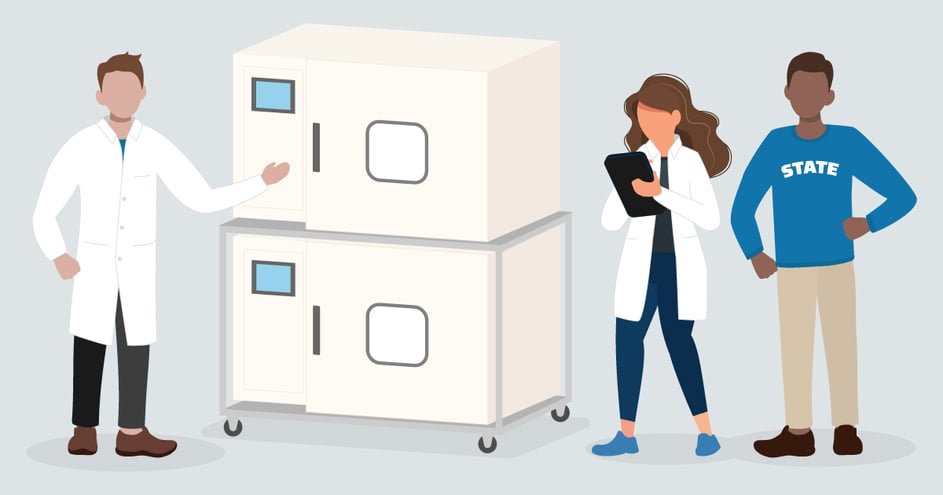The Importance of Environmental Test Chambers to University Research

Universities and colleges serve as centers for innovation and research, addressing some of the world’s most critical challenges.
To support these institutions, environmental test chambers are essential, enabling researchers to simulate various environmental conditions within a controlled workspace. From climate research and aerospace testing to battery development, test chambers offer a valuable environment for pioneering research and practical learning experiences for students.
Here’s how some universities have relied on environmental chambers to conduct earth-changing (and beyond) research.
Universities & Colleges Using Environmental Test Chambers
Climate Research
With the growing concern around climate change, environmental test chambers provide researchers with a controlled environment in which they can study the impact of climate change on plants, animals, and ecosystems. By manipulating various environmental conditions, researchers can observe how different organisms respond and adapt to changing climates and ecosystems.
For instance, in 2020, Diné College received a $100,000 environmental chamber for climate research to be conducted by both students and faculty. Used in the School of STEM, science faculty member Dr. Scott Bender says, “This specialized environmental simulation testing chamber enables faculty and students to simulate all climates seen across the Navajo Nation.”
Material & Product Testing
As is common with commercial endeavors, colleges and universities employ environmental chambers to test the durability and performance of different materials and products under extreme environmental conditions. By subjecting materials to high heat and humidity or cold temperatures, researchers can observe how they react and perform. This information can be used to develop new materials or improve existing ones.
For example, in a joint venture between Western Carolina University and Asheville-Buncombe Technical Community College in North Carolina, students and faculty use environmental test chambers in some of their academic coursework. One particular project includes monitoring, testing, and developing a heat pump with added dehumidification capabilities.
Aerospace Research
Some universities look to the stars, utilizing environmental chambers in aerospace research. Chambers can simulate the extreme temperature and pressure conditions of outer space (to a certain extent).
By recreating these conditions, researchers can better understand how different materials and technologies behave in space, making them valuable for testing the performance of spacecraft components, such as thermal insulation.
At the Laboratory for Advanced Space Systems at Illinois (LASSI), part of the Grainger College of Engineering at the University of Illinois Urbana-Champaign, students and faculty have utilized environmental chambers to test their premier space designs. In fact, research with environmental test chambers helped them launch a satellite, CubeSail, on a Rocket Lab Electron rocket from New Zealand in December 2018.
SLAC National Accelerator Laboratory Battery Testing Research
With the societal push for more sustainable energy sources and technologies, many colleges and universities are utilizing environmental chambers for battery testing. Just consider how many electronics, handheld devices, and electric vehicles rely on battery power.
Associated Environmental Systems was able to chat with Vivek Lam, a researcher at the Chueh Lab at the SLAC National Accelerator Laboratory operated by Stanford University for the Department of Energy, asking questions about how they use their environmental test chamber for battery research.
At SLAC, their testing revolves around the intersection of energy storage and data science. Their end goal is to build early prediction models that can accurately forecast the trajectory of a battery’s degradation under arbitrary usage and chemistries. The team can achieve this by calendar aging testing, a process that considers the degradation that occurs when a battery is stored at a fixture temperature and state of change.
To study calendar aging, they store commercial cylindrical and pouch cells inside a temperature chamber and periodically move them into a battery testing chamber with an integrated battery testing fixture for the state of health checkups testing. This periodic state of health checkup shows how the battery degrades over time when stored at specific charges and temperatures.
In our chat with the Chueh Lab, they explained the challenges of working with batteries. For instance, their complex electrochemical systems with dozens of potential degradation models can become convoluted during operation.
When choosing a temperature chamber, safety was important to ensure they could accurately test their cells and keep their lab safe. The lab works directly with cylindrical and pouch cells and the temperature chamber needs to allow for easy insertion of the cells, transferring them from one chamber to another.
For future applications, if the lab was to ever switch battery types, they would need an adaptable battery fixture that can test different cell types.
Advancing Technology & Scholarship
Environmental test chambers are versatile and valuable tools for universities and colleges across a wide range of disciplines.
These chambers not only facilitate groundbreaking research but also provide students with hands-on learning opportunities that prepare them for future careers. As the world faces new challenges and opportunities, it is clear that environmental test chambers will continue to play an important role in advancing science and technology for years to come.
As a leader in designing and manufacturing temperature and humidity test chambers for aerospace, pharma, electronics, automotive, computers, and battery testing worldwide, Associated Environmental Systems (AES) gets it. Contact us today if your college or department wants to share how you use environmental chambers (AES or not). We’d be happy to feature your story.


